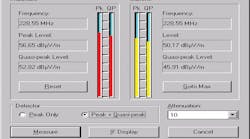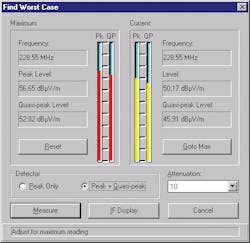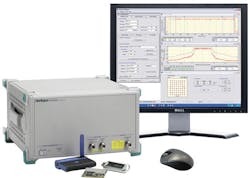Software Simplifies RF/Microwave Testing
Making a high-frequency measurement once involved a rack full of instruments and the knowledge to use it. It still involves the rack, although the shapes and the sizes of the instruments are changing. And some of the knowledge can now be found in the form of software, written to guide engineers through tests ranging from the conventional to the esoteric. Many of the leading names in RF/microwave test equipment are also developers and suppliers of the software, lending their expertise and experience to those willing to load the code on their computers.
Measurement software for RF/microwave applications comes in many forms and for many applications—including for performing measurements according to communications protocols, such as IEEE 802.11 for wireless local area networks (WLANs), for electromagnetic-compatibility (EMC) analysis, and for spectral analysis of operating environments. Any review of measurement software should probably start with LabVIEW from National Instruments due to its widespread use in the industry. It is a powerful suite of automated test tools that can simplify system-level integration of multiple instruments and use the firm’s own modular test instruments to create virtual instruments and systems capable of many unique, user-definable functions.
The latest version of the system test software, LabVIEW 2012, features improved stability and analysis power, numerous added toolkits, including a biomedical toolkit, templates to help users get started by working with a proven system configuration, and a host of new analysis and simulation capabilities. The software in its many versions is written for the Microsoft Windows® operating system and designed for use with the firm’s many modular software-define-radio (SDR) test instruments, as well as instruments from other manufacturers.
For engineers working in specific areas, LabVIEW offers numerous toolkits and measurement suites devoted to test products in a particular technology—such as the NI WLAN generation toolkit, analysis toolkit, and measurement suite—for physical-layer measurements on IEEE 802.11a/b/g wireless-local-area-network (WLAN) designs. When teamed with National Instruments’ models NI PXIe-5663 vector signal analyzer (VSA) and NI PXIe-5673 vector signal generator (VSG), the software can perform a wide range of measurements on both WLAN semiconductors and fully integrated devices and systems. These include error vector magnitude (EVM); frequency offset; in-phase/quadrature (I/Q) gain imbalance; quadrature skew; carrier suppression; spectral flatness; spectral mask margin; power ramp-up and ramp-down times; and peak, average, and gated power levels. The measurement suite includes the NI WLAN Analysis Toolkit for RF VSAs and the NI WLAN Generation Toolkit for RF VSGs.
For spectral analysis, the NI Spectral Measurements Toolkit can control such measurements as power spectrum, peak power and frequency, in-band power, adjacent-channel power, and occupied bandwidth. It is a suite of programs for use within LabVIEW as well as in LabWindows/CVI measurement development software. It can also provide three-dimensional (3D) spectrograms of results. This software can work with the PXI-5660 RF VSA, digitizers, and other modular instrument hardware from a variety of suppliers. The Spectral Measurements Toolkit is designed to perform modulation-domain functions such as converting digitally modulated in-phase (I) and quadrature (Q) signals to intermediate frequencies (IFs), as well as generating and analyzing analog modulated signals.
Agilent Technologies, well known for its diversity of test hardware, also supplies Signal Studio software for the generation of complex signals found in modern communications systems [including in cellular and WLAN systems and satellite-communications (satcom) systems]. The firm recently announced that it had enhanced its model N7609B Signal Studio for Global Navigation Satellite Systems (GNSS) software , intended for simulation of Galileo signals for receiver testing. The software can now coordinate real-time, multiple-satellite simulations for the European Galileo satellite system, a navigation constellation similar to the US Global Positioning System (GPS).
The Signal Studio software for Galileo testing can generate signals that simulate signals from Galileo satellites, or else a combination of Galileo, GPS, or even Russian GLONASS navigation satellites. Users can create different signal scenarios based on the locations of satellite at different dates and times, for the purposes of evaluating satellite-positioning chipsets and other products. Chipsets and other hardware are being introduced for this system, which is expected to be completed in 2019 with 27 operational satellites and 3 spare vehicles.
Signal Studio is a Windows/Windows NT program that works with the firm’s modular test hardware (such as arbitrary waveform generators and VSGs) to produce a wide array of test and simulation signals—including for fixed and mobile WiMAX; WLANs; Bluetooth; cellular communications; and detection, positioning, and tracking applications. For example, the software simplifies pulse building. This allows users to precisely define all pulse parameters, such as frequency, phase, pulse repetition interval (PRI), pulse width, and even with chirp and other intra-pulse modulation. Pulse configurations can be stored in ASCII and other file formats to conveniently build a library or reusable test-signal formats.
The company also offers more specialized test programs, such as the Agilent PDQ-WLR™ test and analysis software for wafer-level-reliability (WLR) testing and analysis on Windows NT and HPUX computer platforms. The test software has more than 30 WLR algorithms and can evaluate all major semiconductor reliability failure mechanisms, including electromigration, oxide breakdown, and plasma damage. The software can also coordinate post-test statistical and physical analysis of the data taken during testing.
Rohde & Schwarz also offers some specialized test software packages, including its R&S ESxS-K1 electromagnetic-interference (EMI) measurement software. The software is written for the company’s wide range of measurement receivers; it helps simplify measurement setup, data capture and display, and test data analysis. On-screen color displays can include limit lines, while using automatic data reduction to remove unneeded results. The software includes many helpful functions, including a zoom feature for closer looks at displays, automatic peak search, and a worst-case function to find the maximum hold level (Fig. 1). The software allows data to be exported to other programs, including Excel.
1. The R&S ESxS-K1 EMI measurement software provides numerous features that simplify the capture of peak power levels during testing. [Photo courtesy of Rohde & Schwarz (www.rohde-schwarz.com).]
In tune with emerging needs, Rohde & Schwarz also has created the R&S FS-K112PC near-field-communications (NFC) measurement software to characterize the RF parameters of signals from devices equipped with NFC capabilities. The software is written for use with the firm’s FSV/FSL series spectrum analyzers and its RTO family of digital oscilloscopes. The software provides automatic detection of NFC-A, NFC-B, and NFC-F transmission methods or can be preset for testing any one of the configurations. It can also measure voltage profiles, modulation depth, modulation index, and load modulation. In addition, it can provide full testing of timing parameters, including rise and fall times, frame delay time, overshoot, and undershoot.
The latest version (Version 5) Automated Tuner System Software from Maury Microwave is easy-to-use device characterization software in spite of its functional power. Written for Windows XP and Windows 7 operating systems, the software works with the firm’s impedance tuners and additional commercial signal generation and analysis test hardware to measure an extensive list of device parameters. These include gain, noise figure, power, efficiency, intermodulation distortion, adjacent-channel power ratio, error vector magnitude, and harmonics. It can also export test results into the Advanced Design System (ADS) simulation software suite from Agilent Technologies for modeling and simulation. This latest version simplifies impedance-tuner control with a new graphical user interface (GUI). It also provides a new means of performing cascaded load-pull measurements without need of diplexers or triplexers.
Teseq, which specializes in EMC compliance emission and immunity software, has created its Compliance 5 software based on expertise and experience. With an extensive driver data base available on the firm’s website, the software supports more than 350 test instruments for EMC testing. The software even includes a driver editing tool so that users can create their own instrument drivers. Compliance 5 is supplied with a dedicated package for making compliant measurements to awide range of commercial standards, including EN 55011 and EN 55022 for emissions and IEC 61000-4-3 and IEC 61000-4-6 for immunity testing.
In addition, the software is available for use with a wide range of optional automotive, aerospace, and military emissions and immunity standards, such as military MIL-STD-461C/D/F for emissions and MIL-STD-461E/D/F for immunity. Compliance 5 uses simple forms specific to each test to allow a user to make simple selections before beginning a test. Measurement requirements, such as limits for frequency and test levels are preloaded with each test. It includes helpful reporting functions to simplify that part of the EMC compliance process. Data can be imported from a number of different formats, including Notepad, CSV, and Tab Delimited file formats. Once measurements are made, the software allows files to be saved in real-text-format (RTF), MS Word, or PDF files.
AR RF/Microwave Instrumentation now makes its SW1007 electromagnetic-compatibility (EMC) test software available free of charge. It automatically performs both calibration and immunity testing and is available as a free download from the company’s website. It features military standard (MIL STD) emissions capabilities (such as MIL-STD-461/462), along with its legacy radiated susceptibility and conducted immunity measurement capabilities. It is compliant to IEC-61000-4-3 commercial requirements for radiated immunity and IEC-61000-4-6 requirements for conducted immunity, as well as automotive and aerospace standards. The standalone software is written for Windows.
Many instrument suppliers support their hardware with complementary software packages, such as the Tektronix Application Developer Toolkit from Tektronix for integrating the analysis capabilities of the MATLAB mathematical software from MathWorks directly with one of their digital oscilloscopes. The combination allows users to create custom math functions and provides fast, efficient access to captured waveform data, with the ease of a computer GUI tailored for the tasks. Similarly, the MT8860C WLAN test solution combines dedicated test hardware with a PC software program (Fig. 2) for full IEEE 802.11b/g/a/n transmitter and receiver testing. The hardware has a built-in reference receiver and transmitter analyzer and the software builds on the firm’s CombiTest measurement software to simplify testing in production environments.
2. The MT8860C WLAN test set combines hardware and software for production-line testing of WLAN transmitters and receivers. [Photo courtesy of Anritsu Co. (www.anritsu.com).]
This has been a brief sampling of the many RF/microwave test software tools currently available. The list of additional suppliers is long; it includes Aeroflex, Anritsu Co., Boonton, ETS-Lindgren, Giga-tronics, LeCroy, and Tektronix.


